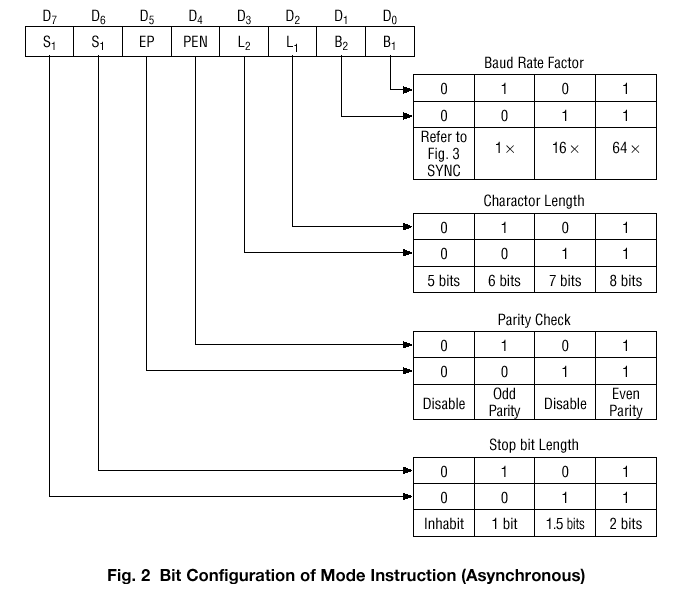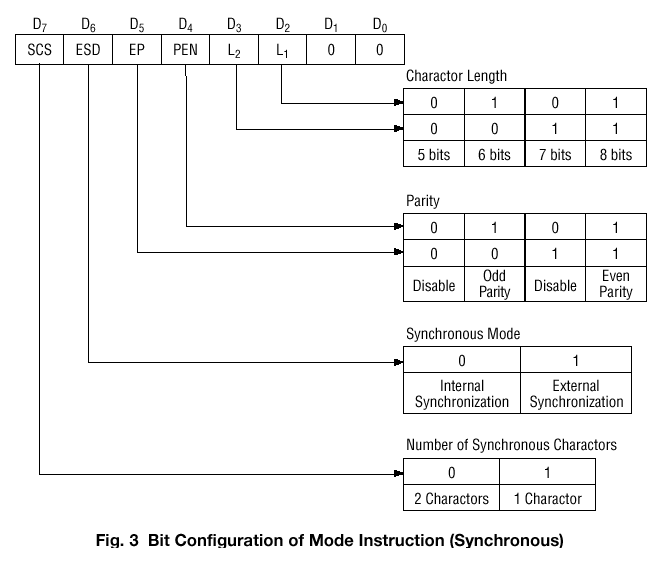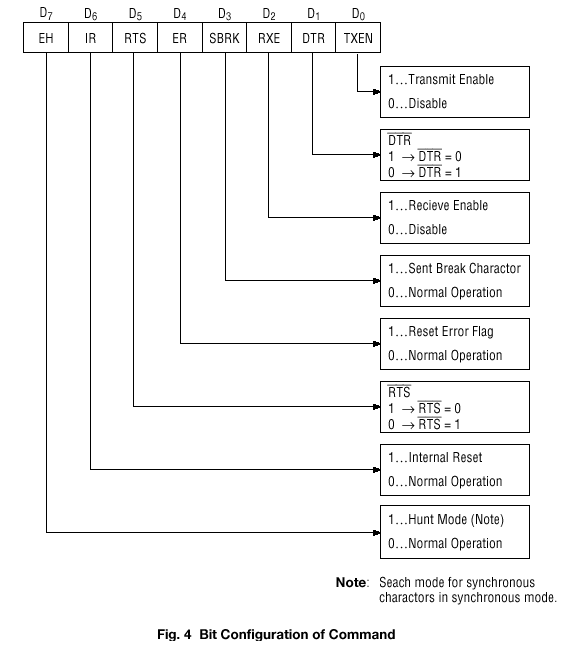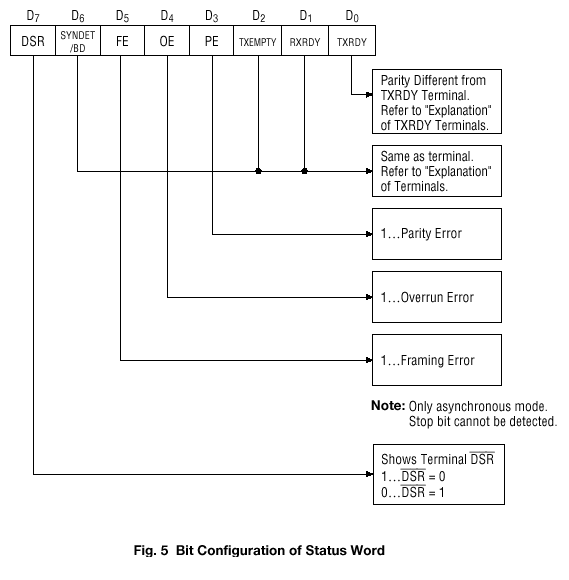
The 8251 is a USART (Universal Synchronous Asynchronous Receiver Transmitter) for serial data communication. As a peripheral device of a microcomputer system, the 8251 receives parallel data from the CPU and transmits serial data after conversion. This device also receives serial data from the outside and transmits parallel data to the CPU after conversion.

Block diagram of the 8251 USART (Universal Synchronous Asynchronous Receiver Transmitter)
The 8251 functional configuration is programed by software. Operation between the 8251 and a CPU is executed by program control. Table 1 shows the operation between a CPU and the device.

Table 1 Operation between a CPU and 8251
There are two types of control word.
1. Mode instruction (setting of function)
2. Command (setting of operation)
Mode instruction is used for setting the function of the 8251. Mode instruction will be in "wait for write" at either internal reset or external reset. That is, the writing of a control word after resetting will be recognized as a "mode instruction."
Items set by mode instruction are as follows:
Synchronous/asynchronous mode
Stop bit length (asynchronous mode)
Character length
Parity bit
Baud rate factor (asynchronous mode)
Internal/external synchronization (synchronous mode)
Number of synchronous characters (Synchronous mode)
The bit configuration of mode instruction is shown in Figures 2 and 3. In the case of synchronous mode, it is necessary to write one-or two byte sync characters. If sync characters were written, a function will be set because the writing of sync characters constitutes part of mode instruction.


Command is used for setting the operation of the 8251. It is possible to write a command whenever necessary after writing a mode instruction and sync characters.
Items to be set by command are as follows:
Transmit Enable/Disable
Receive Enable/Disable
DTR, RTS Output of data.
Resetting of error flag.
Sending to break characters
Internal resetting
Hunt mode (synchronous mode)

It is possible to see the internal status of the 8251 by reading a status word. The bit configuration of status word is shown in Fig. 5.

D 0 to D 7 (l/O terminal)
This is bidirectional data bus which receive control words and transmits data from the CPU and sends status words and received data to CPU.
RESET (Input terminal)
A "High" on this input forces the 8251 into "reset status." The device waits for the writing of "mode instruction." The min. reset width is six clock inputs during the operating status of CLK.
CLK (Input terminal)
CLK signal is used to generate internal device timing. CLK signal is independent of RXC or TXC. However, the frequency of CLK must be greater than 30 times the RXC and TXC at Synchronous mode and Asynchronous "x1" mode, and must be greater than 5 times at Asynchronous "x16" and "x64" mode.
WR (Input terminal)
This is the "active low" input terminal which receives a signal for writing transmit data and control words from the CPU into the 8251.
RD (Input terminal)
This is the "active low" input terminal which receives a signal for reading receive data and status words from the 8251.
C/D (Input terminal)
This is an input terminal which receives a signal for selecting data or command words and status words when the 8251 is accessed by the CPU. If C/D = low, data will be accessed. If C/D = high, command word or status word will be accessed.
CS (Input terminal)
This is the "active low" input terminal which selects the 8251 at low level when the CPU accesses. Note: The device wont be in "standby status"; only setting CS = High.
TXD (output terminal)
This is an output terminal for transmitting data from which serial-converted data is sent out. The device is in "mark status" (high level) after resetting or during a status when transmit is disabled. It is also possible to set the device in "break status" (low level) by a command.
TXRDY (output terminal)
This is an output terminal which indicates that the 8251is ready to accept a transmitted data character. But the terminal is always at low level if CTS = high or the device was set in "TX disable status" by a command. Note: TXRDY status word indicates that transmit data character is receivable, regardless of CTS or command. If the CPU writes a data character, TXRDY will be reset by the leading edge or WR signal.
TXEMPTY (Output terminal)
This is an output terminal which indicates that the 8251 has transmitted all the characters and had no data character. In "synchronous mode," the terminal is at high level, if transmit data characters are no longer remaining and sync characters are automatically transmitted. If the CPU writes a data character, TXEMPTY will be reset by the leading edge of WR signal. Note : As the transmitter is disabled by setting CTS "High" or command, data written before disable will be sent out. Then TXD and TXEMPTY will be "High". Even if a data is written after disable, that data is not sent out and TXE will be "High".After the transmitter is enabled, it sent out. (Refer to Timing Chart of Transmitter Control and Flag Timing)
TXC (Input terminal)
This is a clock input signal which determines the transfer speed of transmitted data. In "synchronous mode," the baud rate will be the same as the frequency of TXC. In "asynchronous mode", it is possible to select the baud rate factor by mode instruction. It can be 1, 1/16 or 1/64 the TXC. The falling edge of TXC sifts the serial data out of the 8251.
RXD (input terminal)
This is a terminal which receives serial data.
RXRDY (Output terminal)
This is a terminal which indicates that the 8251 contains a character that is ready to READ. If the CPU reads a data character, RXRDY will be reset by the leading edge of RD signal. Unless the CPU reads a data character before the next one is received completely, the preceding data will be lost. In such a case, an overrun error flag status word will be set.
RXC (Input terminal)
This is a clock input signal which determines the transfer speed of received data. In "synchronous mode," the baud rate is the same as the frequency of RXC. In "asynchronous mode," it is possible to select the baud rate factor by mode instruction. It can be 1, 1/16, 1/64 the RXC.
SYNDET/BD (Input or output terminal)
This is a terminal whose function changes according to mode. In "internal synchronous mode." this terminal is at high level, if sync characters are received and synchronized. If a status word is read, the terminal will be reset. In "external synchronous mode, "this is an input terminal. A "High" on this input forces the 8251 to start receiving data characters.
In "asynchronous mode," this is an output terminal which generates "high level"output upon the detection of a "break" character if receiver data contains a "low-level" space between the stop bits of two continuous characters. The terminal will be reset, if RXD is at high level. After Reset is active, the terminal will be output at low level.
DSR (Input terminal)
This is an input port for MODEM interface. The input status of the terminal can be recognized by the CPU reading status words.
DTR (Output terminal)
This is an output port for MODEM interface. It is possible to set the status of DTR by a command.
CTS (Input terminal)
This is an input terminal for MODEM interface which is used for controlling a transmit circuit. The terminal controls data transmission if the device is set in "TX Enable" status by a command. Data is transmitable if the terminal is at low level.
RTS (Output terminal)
This is an output port for MODEM interface. It is possible to set the status RTS by a command.